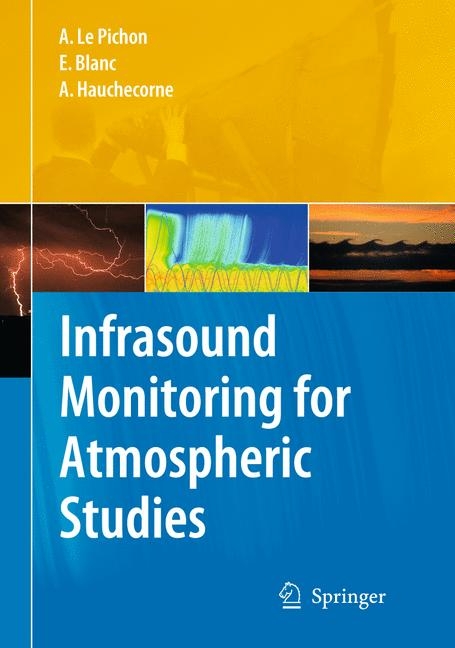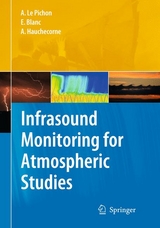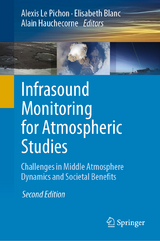Infrasound Monitoring for Atmospheric Studies
Springer-Verlag New York Inc.
978-1-4020-9507-8 (ISBN)
- Titel erscheint in neuer Auflage
- Artikel merken
Readers will benefit from the comprehensive content of infrasound related topics and contributions by recognized experts.
The use of infrasound to monitor the atmosphere has, like infrasound itself, gone largely unheard of through the years. But it has many applications, and it is about time that a book is being devoted to this fascinating subject. Our own involvement with infrasound occurred as graduate students of Prof. William Donn, who had established an infrasound array at the Lamont-Doherty Geological Observatory (now the Lamont-Doherty Earth Observatory) of Columbia University. It was a natural outgrowth of another major activity at Lamont, using seismic waves to explore the Earth’s interior. Both the atmosphere and the solid Earth feature velocity (seismic or acoustic) gradients in the vertical which act to refract the respective waves. The refraction in turn allows one to calculate the respective background structure in these mediums, indirectly exploring locations that are hard to observe otherwise. Monitoring these signals also allows one to discover various phenomena, both natural and man-made (some of which have military applications).
A. Le Pichon (Master Degree in Fundamental Physics. PhD in Acoustics) Since 1998, geophysicist at the French National Data Center (NDC), hosted by CEA/DASE, in charge of Infrasound research activities on topics relevant to Comprehensive Nuclear-Test-Ban Treaty Organization (CTBTO): signal processing for automated detection and source location procedures, propagation modeling, methods for source characterization. E. Blanc: Research director at CEA. Main research areas are infrasound and gravity waves, electrodynamical coupling of the atmospheric layers, atmospheric disturbances produced by lightning and sprites. She coordinated international research projects: study of infrasound from strong chemical explosions in USA and in Russia, HF radar observations of the disturbances of the equatorial ionosphere, space observations of lightning and sprite. A. Hauchecorne (Research director at CNRS; since 2005 Director of Aeronomy Service Laboratory):Main research areas are dynamics and climatology of the middle atmosphere; transport and mixing of ozone and minor constituents in the stratosphere; analysis of satellite data analysis and data assimilation in the field of stratospheric chemistry; lidar techniques for the measurement of stratospheric parameters.
Part I. History, Instrumentation, Network.- 1. The Characteristics of Infrasound, its Propagation and Some Early History.- 2. The IMS Infrasound Network: Design and Establishment of Infrasound Stations.- 3. Monitoring the Earth’s Atmosphere with the Global IMS Infrasound Network.- 4. Specifications of Low-Noise Broadband Microbarometers.- 5. A Review of Wind-Noise Reduction Methodologies.- Part II. Sources, Observations, and Propagation. 6. Worldwide Observations of Infrasonic Waves.- 7. Infrasonic Observations of Open Ocean Swells in the Pacific:Deciphering the Song of the Sea.- 8. Generation of Microbaroms by Deep-Ocean Hurricanes.- 9. Acoustic-Gravity Waves from Earthquake Sources.- 10. Seismic Waves from Atmospheric Sources and Atmospheric/Ionospheric Signatures of Seismic Waves.- 11. Acoustic-Gravity Waves from Impulsive Sources in the Atmosphere.- 12. Meteor Generated Infrasound: Theory and Observation.- 13. High-latitude Observations of Infrasound from Alaska and Antarctica: Mountain Associated Waves and Geomagnetic/Auroral Infrasonic Signals.- 14. Some Atmospheric Effects on Infrasound Signal Amplitudes.- 15. Atmospheric Variability and Infrasound Monitoring.- Part III. Propagation Modeling in a Realistic Atmosphere.- 16. On the Prospects for Acoustic Sounding of the Fine Structure of the Middle Atmosphere.- 17. Numerical Methods to Model Infrasonic Propagation Through Realistic Specifications of the Atmosphere.-18.Misty Picture: A Unique Experiment for the Interpretation of the Infrasound Propagation from Large Explosive Sources.- 19. Ground Truth Events: Assessing the Capability of Infrasound Networks Using High Resolution Data Analyses.- Part IV. Atmospheric Investigations from Global Continuous Infrasound Monitoring. 20. Contribution of Infrasound Monitoring for Atmospheric Remote Sensing.- 21. Global Scale Monitoring of Acoustic and Gravity Waves for the Study of the Atmospheric Dynamics.- 22. Dynamics and Transport in the Middle Atmosphere UsingRemote Sensing Techniques from Ground and Space.- 23. The Representation of Gravity Waves in Atmospheric General Circulation Models (GCMs).- 24. Inversion of Infrasound Signals for Passive Atmospheric Remote Sensing.
| Erscheint lt. Verlag | 14.1.2010 |
|---|---|
| Zusatzinfo | 1 Tables, color; 10 Tables, black and white; 238 Illustrations, color; 144 Illustrations, black and white; XIX, 735 p. 382 illus., 238 illus. in color. |
| Verlagsort | New York, NY |
| Sprache | englisch |
| Maße | 155 x 235 mm |
| Gewicht | 1314 g |
| Themenwelt | Naturwissenschaften ► Biologie ► Ökologie / Naturschutz |
| Naturwissenschaften ► Geowissenschaften ► Geologie | |
| Naturwissenschaften ► Physik / Astronomie ► Mechanik | |
| Technik ► Umwelttechnik / Biotechnologie | |
| ISBN-10 | 1-4020-9507-4 / 1402095074 |
| ISBN-13 | 978-1-4020-9507-8 / 9781402095078 |
| Zustand | Neuware |
| Haben Sie eine Frage zum Produkt? |
aus dem Bereich





